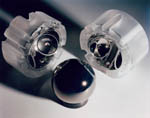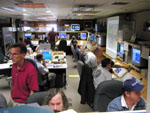WEEKLY HIGHLIGHTS FOR 6 AUGUST 2004:
GRAVITY PROBE B MISSION UPDATE


Gravity Probe B has nearly completed the Initial On-Orbit Calibration Phase of the Mission. Last week we completed the fast speed spin-up of all four gyros. This week we completed the low temperature bakeout of the probe and expect to complete spin-axis alignment of the final two gyroscopes this weekend. Prior to starting the Science Phase of the Mission, we decided to increase the roll rate of the spacecraft from .52rpm to .75rpm which will improve the accuracy of the experiment and minimize the risk of achieving a good measurement in the event of a shortened mission. We plan to increase the roll rate early next week. At that point we will transition to the Science Phase of the mission.
The low temperature bakeout operation was done in order to minimize the pressure inside the vacuum probe. The resulting low pressure, or ultra-high vacuum, is required to minimize the spindown rate and torques on the gyroscopes. The low temperature bakeout process involved heating the probe to approximately 6-7 degrees Kelvin while the probe was open to the vacuum of space. This allowed excess helium gas to escape to space. The probe was then closed to space and the heaters turned off. The probe temperature then returned to its nominal value and the remaining helium was adsorbed into the cryopump. The cryopump is a passive device made of sintered titanium, which has a very large adsorbing area. GP-B's low temperature bakeout process created pressure inside the vacuum probe less than one thousandth that of space.
We continued to perform spin axis alignment of the gyroscopes this week. This is performed using the Gyro Suspension System in a special oscillation mode to slowly align each gyro spin axis to be in nearly perfect alignment with the Guidestar. Having the gyros aligned at the beginning of the mission makes any precession caused by general relativity simpler to measure. Thus far, we've completed the alignment of gyro #1 and #2. Gyro's #3 and #4 should be completed this weekend.
After much analysis and discussion this week we decided to increase spacecraft roll rate during the science mission from .52 rpm to .75 rpm. A .75 rpm roll rate minimizes the risk of events which might occur that could cause degradation to the accuracy of the mission. In addition, by combining the factors that influence gyro accuracy and guide star acquisition, this relatively small increase in roll rate should produce a ~20% improvement in the overall accuracy of the experiment. We expect to perform this operation beginning Monday. Assuming success, we then will begin drag-free operation with the start of the Science Mission Phase later next week.
The spacecraft is being controlled from the Gravity Probe B Mission Operations Center, located here at Stanford University. The
Stanford-NASA/MSFC-Lockheed Martin operations team is continuing to perform superbly.


Images & Photos: The diagram of the gyro rotor and housings is also from the GP-B Image Archive. The first photo, showing the GP-B gyroscope rotor (sphere) and housings, was taken by photographer Don Harlan. In the next two photos, taken by GP-B Public Affairs Coordinator, Bob Kahn, team members in the GP-B Mission Operations Center here at Stanford are spinning up gyro #4 to full speed. Click on the thumbnails to view enlarged copies of these images.
More links on recent topics
- Track the satellite in the sky
- Photo, video & and news links
- Build a paper model of the GP-B Spacecraft
- Following the mission online
- Our mailing list - receive the weekly highlights via email
- The GP-B Launch Companion in Adobe Acrobat PDF format. Please note: this file is 1.6 MB, so it may take awhile to download if you have a slow Internet connection.
Previous Highlight
Index of Highlights
